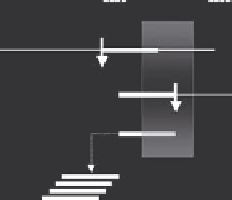Chemistry Reference
In-Depth Information
Cytosol membrane
lumen
APP (~700 aa)
COOH
β
-
secretase
H
2
N
γ
-
secretase
A
β
40/42
Plaque accumulation
Figure 11.1
The amyloid hypothesis inAlzheimer's disease.The transmembrane protein amyl-
oid precursor protein (APP) is cleaved first by
β
-secretase (BACE), then by
γ
-secretase. The
resulting peptidic fragment, A
β
40
/
42
, is liberated, leading to plaque accumulation.These plaques
are associated with neuronal degeneration.
11.2 Overview: Fragment-based Lead Generation
At the outset of our program at AstraZeneca, the development of several high-affinity
peptide-based inhibitors had been reported together with their binding mechanism as
determined by co-crystallography.
[
17
]
However, no small-molecule inhibitors had yet been
disclosed.We initially used traditional lead generation methods to identify starting points as
BACE inhibitors. Our first approach was based on high-throughput screening (HTS) of our
entire corporate collection at 10 M concentration and a subset at 30 M concentration. We
obtained numerous hits in the affinity range IC
50
0.5-5 M, but follow-up efforts showed
that these were forming aggregates or were otherwise not active site directed. Our second
approach involved the design of peptidomimetics based on published co-crystal structures
of BACE or the related aspartyl protease inhibitors renin and HIV protease. All hits that
emerged were discounted either because they could not be mechanistically confirmed as
competitive inhibitors or because they lacked the properties to make them suitable as CNS
drugs.
As an alternative, we adopted fragment-based approaches for lead generation. These
methods rely on identifying small compounds (fragments) that bind to the target with
fewer, but stronger binding interactions than those typically associated with drugs.
[
18
]
This
approach is fundamentally different from traditional methods (such as HTS) where hit
compounds are typically larger and bind to the target over a larger interaction area, but
using overall weaker binding points.
Among the principal advantages of fragment-based lead generation methods are the
following. First, because the fragments are small (generally 150-250 Da ), structure space
can be efficiently sampled with smaller screening sets.
19
−
21
Therefore, instead of screening
millions of typical drug-like compounds, only thousands of small compounds may need
to be screened. This makes it possible to use lower throughput screening methodologies.
A second advantage is that because of the small size of any fragment-based hit, even
relatively weak binding affinity must result from efficient interactions with the target.
A 500 Da hit with an affinity of 1 M may be more challenging to optimize than a 150 Da
hit with 1mM affinity because the larger, higher affinity hit probably binds with a wider
network of weaker individual interactions that must be maintained or improved during the

